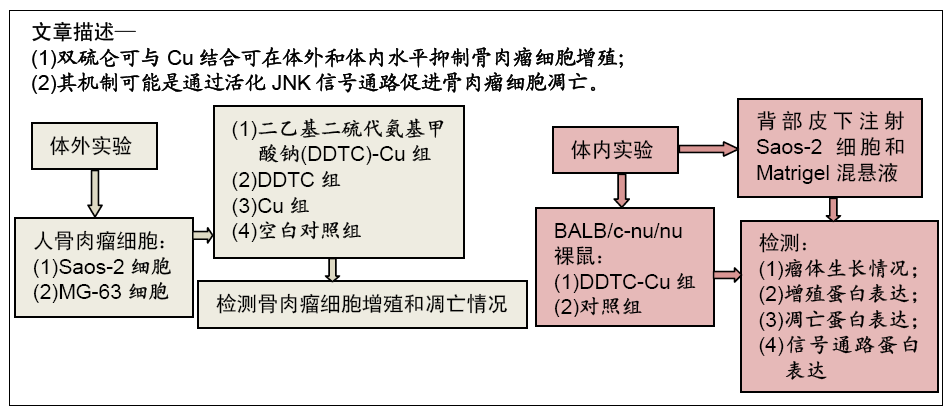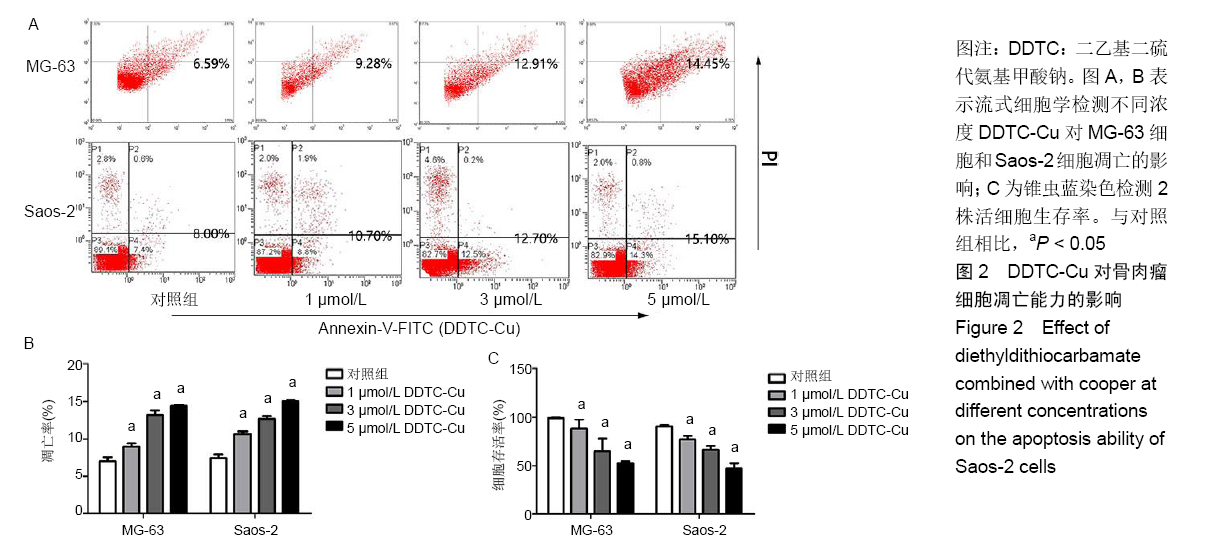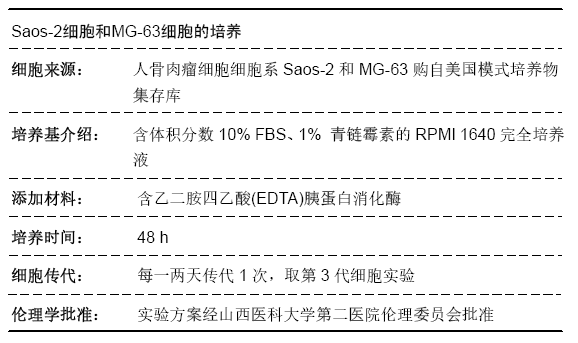中国组织工程研究 ›› 2020, Vol. 24 ›› Issue (1): 124-129.doi: 10.3969/j.issn.2095-4344.1853
• 干细胞基础实验 basic experiments of stem cells • 上一篇 下一篇
双硫仑联合铜离子对人骨肉瘤细胞增殖与凋亡的影响
徐朝健,张 龙,程才统,孙晓娟,吕 智
- 山西医科大学第二医院骨科,山西省太原市 030001
Disulfiram combined with cooper inhibits proliferation and induces apoptosis of osteosarcoma
Xu Chaojian, Zhang Long, Cheng Caitong, Sun Xiaojuan, Lü Zhi
- Department of Orthopedics, Second Hospital of Shanxi Medical University, Taiyuan 030001, Shanxi Province, China
摘要:

文题释义:
双硫仑:是一种广泛用于治疗慢性酒精上瘾以及古柯碱的戒断药物,其为二硫代氨基甲酸盐,水溶性极差。早在20世纪中期,Jacobsen等发现双硫仑可有效抑制乙醛脱氢酶的活性,造成乙醛的饱和氧化反应,其本身和代谢产物可引起体内相关蛋白失活,使人体产生不适反应,从而达到抗酗酒目的。
二乙基二硫代氨基甲酸钠(diethyldithiocarbamate,DDTC):白色至无色片状结晶,有吸湿性,易溶于水,溶于乙醇、甲醇、丙酮,不溶于乙醚和苯。水溶液呈碱性并逐渐分解,遇酸能分离出二硫化碳而使溶液混浊,熔点 94-102 ℃。最大吸收波长(乙醇中)257、290 nm(摩尔吸光系数1 200、13 000)。低毒,半数致死量(大鼠,经口)2 830 mg/kg。研究显示,双硫仑在进入人体后会迅速转化为体内代谢物DDTC,Cu可与DDTC结合形成较稳定的DDTC-Cu复合物。
背景:研究表明双硫仑本身具有抗肿瘤活性,可联合铜(Cu)离子在体内外水平对多种肿瘤发挥抑癌作用,但关于双硫仑对骨肉瘤细胞增殖和凋亡作用的影响尚未阐明。
目的:探讨双硫仑-Cu在体内外水平对骨肉瘤增殖与凋亡能力的影响以及可能的作用机制。
方法:实验方案经山西医科大学动物实验伦理委员会批准(批准号为2017LL077)。①体外实验:配置双硫仑在进入人体后的转换物二乙基二硫代氨基甲酸钠(diethyldithiocarbamate,DDTC)和Cu离子的复合物DDTC-Cu(0.5,1,2,3和5 μmol/L),设置DDTC单药(5 μmol/L)、Cu单药(5 μmol/L)和空白对照组。药物处理人骨肉瘤细胞Saos-2细胞和MG-63细胞,CCK8法检测不同浓度DDTC-Cu对Saos-2细胞和MG-63细胞的增殖抑制作用;采用AnnexinV-FITC/PI双染法检测DDTC-Cu对Saos-2细胞凋亡水平变化;②体内实验:取4周龄BALB/c-nu/nu雌性裸鼠共10只,随机分为DDTC-Cu组和对照组。采用异位移植方法,在裸鼠右侧背部皮下注射Saos-2细胞和Matrigel混悬液(1∶1混合),注射量400 μL/只;接种2周后,对照组裸鼠腹腔注射地塞米松(0.5 mg/kg,隔日1次),DDTC-Cu组裸鼠腹腔注射地塞米松(0.5 mg/kg,隔日1次)和DDTC-Cu复合物(10 nmol/g,隔日1次);观察两组荷瘤小鼠移植瘤生长情况,绘制瘤体生长曲线。接种5周后麻醉下处死动物,完整取出瘤体,免疫组织化学检测瘤体石蜡切片组织中ki67蛋白的表达水平,Western blot检测瘤体组织中细胞增殖和凋亡蛋白的表达及JNK通路蛋白表达的变化。
结果与结论:①体外实验结果:DDTC-Cu组对骨肉瘤细胞的增殖抑制作用明显高于其他3组;CCK-8实验结果显示DDTC-Cu对骨肉瘤细胞增殖抑制呈剂量依赖性,两株细胞的24 h药物半抑制浓度分别为0.337 μmol/L和0.487 μmol/L;流式细胞学检测结果显示DDTC-Cu可呈剂量依赖性促进Saos-2细胞的凋亡;②体内实验结果:DDTC-Cu组裸鼠移植瘤的体积和质量均小于对照组;免疫组织化学结果显示,DDTC-Cu组的瘤体中ki-67蛋白表达水平较对照组降低;Western blot检测结果显示,DDTC-Cu组瘤体蛋白中p-JNK和c-jun的表达水平均上调。结果提示,双硫仑联合Cu离子在体内外水平抑制人骨肉瘤细胞增殖并促进骨肉瘤细胞凋亡,其作用机制可能与JNK通路活化有关。ORCID: 0000-0003-4818-901X(徐朝健)
中国组织工程研究杂志出版内容重点:干细胞;骨髓干细胞;造血干细胞;脂肪干细胞;肿瘤干细胞;胚胎干细胞;脐带脐血干细胞;干细胞诱导;干细胞分化;组织工程
中图分类号:





